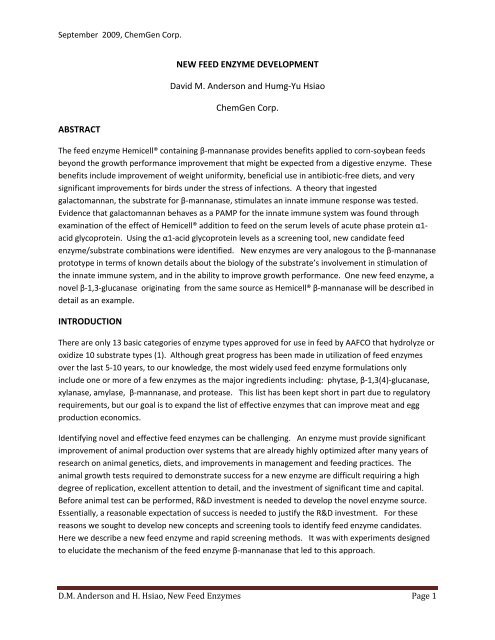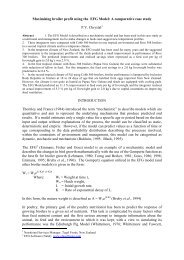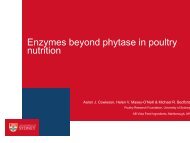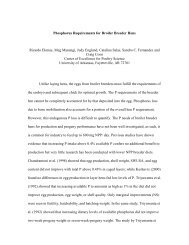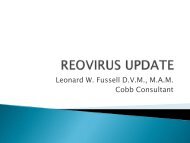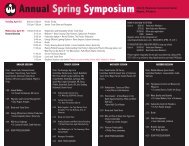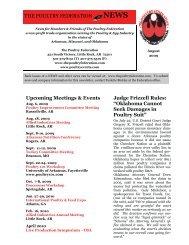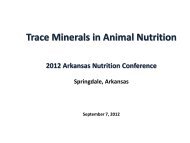New Feed Enzyme Development - The Poultry Federation
New Feed Enzyme Development - The Poultry Federation
New Feed Enzyme Development - The Poultry Federation
- No tags were found...
You also want an ePaper? Increase the reach of your titles
YUMPU automatically turns print PDFs into web optimized ePapers that Google loves.
September 2009, ChemGen Corp.proteins (APP) in blood provides a relatively quick screen to identify other potentially useful enzymesubstratecombinations. APP levels are generally easy to measure since they amplify (or decrease)rapidly upon innate immune system stimulation (14).In this review, example data is presented showing the impact of β‐mannanase on serum AGP levels, andthe inverse relationship between serum AGP and growth performance. <strong>The</strong> rational for a new feedenzyme we have developed is described and how it was initially validated as a good candidate by serumacute phase protein screening. <strong>The</strong> new enzyme’s properties are highly analogous to the qualities of β‐mannanase as a feed enzyme. Both degrade PAMPs in feed that are recognized by hosts PRRs, and bothenzymes we believe increase feeding efficiency primarily through the elimination of a counterproductiveinnate immune response. This novel enzyme for feed has the potential to become another widelyaccepted feed enzyme supplied by ChemGen.ABBREVIATIONSTERMMEANINGAAFCOAmerican Association of <strong>Feed</strong> Control OfficialsAGPα1‐acid glycoproteinamylase α‐amylase (EC 3.2.1.1); pullulanase (EC 3.2.1.41);glucoamylase (EC 3.2.1.3); β‐amylase (EC 3.2.1.2)ANTS8‐anino‐1,3,6,‐naphthalene trisulfonic acidAPPacute phase proteinBDGBrewer’s dry grainsBMDbacitracin methylene disalicylatecfucolony forming unitsChemGen MU million ChemGen units = 4000 IUChemGen Unit (U) 250 International enzyme units (IU)CMPCarboxymethyl pachymanCPCrude proteinCRDcarbohydrate binding domainsDC‐SIGNdendritic cell intercellular adhesion molecule‐3‐grabbing non‐integrinDDGSDistillers dried grain and solublesdpdegree of polymerization (as in the # of sugars in a sugar polymer)FC (or FCR)feed conversion (feed injested/weight gain)GPI‐linkedglycosylphosphatidylinositol linkedHemicellulase enzyme that hydrolyzes a hemicellulose, but historically, a nameparticularly applied to β‐mannanaseHemicellulose any of several non‐celluose carbohydrate polymer components of plantcellsIGF‐Iinsulin like growth factor IIGF‐IIinsulin like growth factor IIIUInternational <strong>Enzyme</strong> Unit ( 1.0 micromole/minute enzyme reaction)MOSmannose oligosaccharidesMRmannose receptorNEFAnonesterified fatty acidsPAMPPathogen Associated Molecular PatternD.M. Anderson and H. Hsiao, <strong>New</strong> <strong>Feed</strong> <strong>Enzyme</strong>s Page 3
September 2009, ChemGen Corp.o C with shaking for 2 hours. <strong>The</strong> test tube was centrifuged and 0.3 ml of upper layer of the reactionmixture was added into 1.2ml ethanol like the prior control. (D) Determination of enzyme releasedsugar: the 80% ethanol solutions were centrifuged, and the total sugar content in the upper 80%alcohol phase was measured. <strong>The</strong> total sugar content after 2 hours of reaction minus the total sugar inthe time zero sample gives the net sugar made soluble in 80% ethanol, thus converted intooligosaccharides by enzyme hydrolysis.RESULTS and DISCUSSIONAtypical effects of Hemicell® feed enzyme in early observationsFigure 1 – Uniformity Examples160140120Control - 905 Birds, CV = 13.4%Hemicell - 967 birds, CV = 11.3%A160140120Control N = 966Hemicell N = 958BFrequency1008060ControlHemicellFrequency1008060ControlHemicell4040202001.41.51.61.71.81.922.12.22.32.42.52.62.72.82.9Body Weight Range33.13.23.33.43.53.63.73.801.41.51.61.71.81.922.12.22.32.42.52.62.72.82.9Body Weight Range33.13.23.33.43.53.6Frequency180160140120100806040200Control, n= 697Hemicell®, n= 698CControlHemicellFrequency vs. weight (Kg) diagram with all birds individuallyweighed. Control population‐ blue line; Hemicell fed populations –red line.(A) Chickens at 49 days pen trial: 905 control birds; 967 birdsfed Hemicell®, conducted at the PARC Institute operatedby James McNaughton.(B) Ducks at 42 days pen trial: 966 control birds, 985Hemicell®, work conducted at <strong>The</strong> Breeding Center ofBeijing Duck, Ministry of Agriculture, China.0.20.30.40.50.60.70.80.911.11.2Body Weight Ranges1.31.41.51.61.7(C) Turkeys at 21 days pen trial: 697 control birds, 698Hemicell birds, conducted at Southern <strong>Poultry</strong> Research.<strong>The</strong> first atypical observation during Hemicell use was increased body weight uniformity. Figure 1provides a few examples of uniformity improvement typically seen in Hemicell® fed poultry. <strong>The</strong> weightdistribution becomes more uniform with the most noticeable difference being decreased frequency oflow weight animals. <strong>The</strong>se were some early observations, but many more examples are available (34).<strong>The</strong> second observation, shown in Figure 2 below, shows the effect of enzymatic digestion of mannan infeed with Hemicell® when birds are under the stress of necrotic enteritis (35‐37). <strong>The</strong> most interestingobservation is that as the infection becomes increasingly severe, the percent improvement forD.M. Anderson and H. Hsiao, <strong>New</strong> <strong>Feed</strong> <strong>Enzyme</strong>s Page 6
September 2009, ChemGen Corp.In a 42 day broiler trialbirds growthwas significantly improved for both Hemicell® andhomogeneousmannanase treatment over no enzyme control, and there was no significant differencee between thetwoenzyme treatments.Figure 3 – Purified Mannanase used in broiler growth studyBroiler Trial -42 DaysA1.91.87aBWAFC1.841.81bb1.781.75Mannanase from Hemicell® was purified by chromatograpy on DEAE‐Sepharose and Phenyl‐Sepharose usingtraditional methods. Panel A: SDS PAGE gel comparing crude Hemicell® and purified mannanase. Panel B: Weightadjusted feed conversionn vs. treatment. Different lower case letters on bars signify statisticallysignificantdifferences(P < 0.05). Conducted at SPR.<strong>The</strong>se results indicate that mannanase is the component important for improved growth in normalhealthy birds, but the pure enzyme was also tested in the necrotic enteritis disease model at Southern<strong>Poultry</strong> Research to besure that mannanase is the component necessary for the even larger percentageimprovements observed vs. infected control . <strong>The</strong> same lot ofpurified mannanase wasused. <strong>The</strong> resultsin Figure 4 demonstrate virtually identical performance for purified mannanase and Hemicell®. <strong>The</strong>setwo feeding trials indicate that mannanase is theactive ingredient. More recent evidence comes fromwork witha heat resistant β‐mannanase. Fermentation broth with heat resistant mannanase washeated at83 °C to inactivate all enzymes except mannanase, and then added in pen trials at 100 MU/tonmannanase and bird performance was compared to a control without mannanase and Hemicell®.Performance between normal and heated heat‐resistant mannanaseis the activeingredient incorn‐ soybean Hemicell® was again equivalent in several tests(data not shown). It is clear that the diets.D.M. Anderson and H.Hsiao, <strong>New</strong> <strong>Feed</strong> <strong>Enzyme</strong>sPage 9
September 2009, ChemGen Corp.Figure 4 –Pure mannanase performance in necrotic enteritismodelCage trial for 21 days conducted at SPRwith the necrotic enteritis model. All treatments infected with E. maxima,E. acervulina, and C. perfringens. Medicated treatment contained Salinomycin 60g/ton and BMD 50 g/ton.Different lower case letters on bars signify statistical significant difference (P < 0.05). Hemicell® or β‐mannanasewere added at 100 MU/ton +/‐ 5 MU. Purified mannanase is as described in Figure 3.Hemicell® <strong>Feed</strong> <strong>Enzyme</strong> and Innate Immune ResponseLegumeslike soybeans contain galactomannan in a portion of the seed called the endospermillustrated in Figure 5. <strong>The</strong> domesticated US soybeans have a very small remaining endosperm.In corn‐soybean diets the galactomannan content is derived essentially all fromthe soybeanmeal (33). <strong>The</strong> 44% protein soybean meals have low galactomannan (estimatedaverage 1.61%) and even lower in48% protein meals made with dehulled beans (estimated average 1.26 %)since much of the endosperm sticks to the tothe hull . <strong>The</strong> active ingredient mannanase onlylowers the molecular weight of galactomannan producing primarily mannose oligosaccharidesas illustrated Figures6 and 7. <strong>The</strong> extent of α‐1,6‐ side chains on the β‐1,4‐mannan backboneaffects the mannan’ssolubility and also the degree of digestion. A higher modification levelincreasess solubility, but also causes somewhat higher degree of polymerization(dp) for a limitdigest. On the otherhand β‐1,4‐mannans with a low galactose modification have low solubilityin water,and water solubility is necessary for efficient β‐mannanase action. <strong>The</strong>galactomannan digestion in Figure 7 uses highy soluble Locust bean gum galactomannan thathas a similar high degree of α‐1,6‐ galactose side chain content as soy galactomannan. It can beseen thatt MOS with dp ranging from 2 to well over 10 isproduced. No fragments are seenwithout mannanase addition.D.M. Anderson and H.Hsiao, <strong>New</strong> <strong>Feed</strong> <strong>Enzyme</strong>sPage 10
September 2009, ChemGen Corp.Figure 5 – Endosperm and galactomannan in LegumesenPhotographs provided by Dr. James A. Lackey. Seed types are (a) Kudzu; (b) wild soybean; (c) US domesticatedsoybean; (d) Guar. <strong>The</strong> endosperm composed largely of galactomannan is labeled “en”. <strong>The</strong> cotyledon or embryois rich in protein and is increased in size in domesticated soybean.Figure 6‐Hydrolysis of Legume galactomannan by endo‐1,4‐β‐D‐mannanase (EC 3.2.1.78) of Hemicell®Legume galactomannanα-1,6-galactoseβ-1,4-mannoseHydrolysis SitesnFigure 7 – Oligosaccarides produced from Locust Bean gum galactomannan1 2 3 4 5 6dp 10dp 4dp 2Acrylamide electrophoresis of oligosaccharides deriviatized withfluorescent ANTS to create negatively charged molecules thatare separated by size (40). Gel composed of 28% acrylamideand 2% bisacrylamide was used and was photographed underUV light. Lane 1 – maltodextrin with degree of polymerization(dp) of 4‐10; Lane 2‐ maltodextrin dp 2‐4; lane 3 – glucose ;Lane 4 – Locust bean gum; Lane 5 and 6– Locust bean gumgalactomannan digested by Hemicell® mannanase. Glucose runsin the dye front including non reacted ANTS.D.M. Anderson and H. Hsiao, <strong>New</strong> <strong>Feed</strong> <strong>Enzyme</strong>s Page 11
September 2009, ChemGen Corp.<strong>The</strong> mechanism for β‐mannanase function requires only the reduction of the molecular weight.<strong>The</strong> enzyme α‐galactosidase is co‐expressed in most microbial strains that make, β‐mannanaseand this enzyme could create more extensive breakdown of galactomannan if the α‐galactosidase is a type capable of reacting with MOS. <strong>The</strong> data here shows that a furtherdegradation of soy galactomannan into monosaccharides is not necessary since purified β‐mannanase alone provides the effect.Mannan and the innate immune systemMannans of various types are recognized PAMPs by the innate immune system by several PRRincluding the serum protein mannose binding lectin (MBL) as well as several cell surfacereceptors including mannose receptor (MR) and others (DC‐SIGN) on key immune system cells.Toll Like receptors (TLR2, TLR4, TLR6) are involved in signal transduction after mannan binding(10‐13). <strong>The</strong> association of mannan with the surface of numerous pathogens has likely led tomannan’s conserved recognition by the innate immune system. <strong>The</strong> MBL is particularlyinteresting since humans with defective variants were found to have a high frequency of certaininfections (64). Recently MBL has been recognized to be involved in the phagocytosis ofmannose containing pathogens and recycle of necrotic cells that effectively aligns cell surfaceTLR binding for signal transduction (12).As illustrated in Figure 8, MBL associates into structures that have multiple CRD (carbohydradebinding domains). Each individual CRD does not bind mannose very tightly, but a highmolecular weight mannose polymer on a pathogen surface binds tightly and activates aresponse. Higher concentrations of mannose or mannose oligosaccharides can in fact inhibitbinding to mannan specific PRR binding as has been shown various in vitro experiments forexample with HIV and Influenza(41‐42).Figure 8 – Multi‐CRD binding site structure of MBLD.M. Anderson and H. Hsiao, <strong>New</strong> <strong>Feed</strong> <strong>Enzyme</strong>s Page 12
September 2009, ChemGen Corp.First the purified β‐1,3‐glucanase was characterized to establish the purity and specificity of the enzyme.<strong>The</strong> purified enzyme was not 100% pure, but highly purified and free of other glucanases (amylase andcellulase) . <strong>The</strong> purity is analyzed in Figure 12 and specificity in Figure 13.Figure 12 ‐ Purified β‐1,3‐glucanase on SDS‐PAGE gelPurified β‐1,3‐glucanase from Hemicell®production host strain analyzed on SDSpage gel (Lanes 2 and 3) compared toBio‐Rad standard broad range proteinmolecular weight markers (Lane 1).Marked bands on the left are molecularweights in kilo Daltons.Lane 2, normal loading, Lane 3, heavyloading to check purity. <strong>The</strong> β‐1,3‐glucanase is marked with an arrow.Figure 13‐ Verification of the specificity of purified β‐1,3‐glucanase with defined β‐1,3‐glucans, CMPand ScleroglucanCarbohydrate gel as described in Figure 7modified with higher % gel. CMP and wasobtained from Megazyme and Scleroglucanfrom Cargill.Carbohydrate Gel lanes1‐glucose (dp 1)2‐ maltose (dp 2)3‐maltotriose( dp 3)4‐ maltodextrin (dp 4‐10)(dp 8‐10 not resolved )5‐ CMP (contaminated with glucose, noenzyme)6,8 –CMP (carboxymethyl pachyman)digest, two levels loading7,9 – scleroglucan digest, two levelsloading32% acrylamine gel, 2 hours, 200 VLanes 6‐9 digested withβ‐1,3‐glucanase before ANTS reaction<strong>The</strong> purified β‐1,3‐glucanase was able to digest two known available polymers with β‐1,3‐glucanbackbone, carboxymethy pachyman and sclerogucan. Further the gels show that that the enzyme hadD.M. Anderson and H. Hsiao, <strong>New</strong> <strong>Feed</strong> <strong>Enzyme</strong>s Page 17
September 2009, ChemGen Corp.endo cutting ability since oligosaccharides with a dp in the range of 2‐7 arevisible on the gel, but uncutCPM did not display any of these fragments.<strong>The</strong> mannan and β‐1,3‐glucan analysis summaryfor DDGS samples are shown in Table 5 as analyzedasdescribedd in the Materials and Methods section. A mannose content (total: 1.5%; soluble: 0.9%) inDDGS wasmeasured (see Figures 14and 15 for individual sugar data) and β‐1,3‐glucann content of 1.2‐1.5 % is predicted. Measured β‐1,3‐glucan by enzyme digestion in the soluble fractionis comparedtomannan data in Figure16.Table 5 – Summary of mannan andβ‐1,3‐glucann content (%)in DDGS samples%OilCPmannanβ‐1,3‐glucan Corn3.337.50.05 0DDGS1026‐281.2‐1.51.2‐1.5Yeast408‐98‐9Figure 14‐ Sugar analysis of DDGS samples by GCTop Panel – Mannose DataBottom Panel – Glucose DataData is shown as average ofthree DDGS sampless from eachcompany. Blue bars show thesugar polymer content thatcould be extracted readily withwater. <strong>The</strong> Red bars show thesugar that could be hydrolyzedby acid (note, not strong acid socellulose is excluded).Some DDGS samples have a lotof leftover starch based on theglucose analysis.D.M. Anderson and H.Hsiao, <strong>New</strong> <strong>Feed</strong> <strong>Enzyme</strong>sPage 18
September 2009, ChemGen Corp.Figure 15: Analysis of xylose sugar content of DDGS samples% DW10.08.06.04.02.0SolubleTotal XyloseA highh xylose content isexpected in all DDGS samplesdue toconcentrating the cornxylan by three times. However,its almost all poorlysoluble.0.0#1‐3#4‐6 #7‐9#10‐12 #13‐15Source of DDGSFigure 16 – Determination of available β‐1,3‐glucan in individual DDGS samples by GCand purifiedβ‐1,3‐glucanase digestion (see Materials and Methods).<strong>The</strong> ethanol fermentation process removes the starch from the corn adding solubles and whole yeastinto the DDGS by‐product. So in Table 5 corn and yeast are compared to the DDGS. About three tons ofcorn results in one tonDDGS. <strong>The</strong> oil content inDDGS is thus about threee times the oil level in cornunless it isextracted out. Mannosecontent (total: 1.5%; soluble: 0.9%) in DDGS mainlycomes fromadded yeast since the mannan content in corn isonly 0.05%. Since 8‐9% dry wt. of yeast is mannan,DDGS contains about 12‐14% yeast. <strong>The</strong> Crude Protein (CP) in DDGS is 4‐5 % points higher than threetimes the corn protein factor. This extra proteinis from yeast since it contains 40% CP. <strong>The</strong> observed β‐1,3‐glucancontent in the soluble fraction was generally lower than the soluble mannan fraction. Bothmust alsobe derived from the yeast content. <strong>The</strong> relatively high yeast content in DDGS means thatt inhigh DDGS diets, the available β‐1,33 glucan content in the diet can be similar to the galactomannannlevels encountered in soy diets, andmuch higher than the 100 ppm wheree negative effects wereobserved in ADG in swine (62).D.M. Anderson and H.Hsiao, <strong>New</strong> <strong>Feed</strong> <strong>Enzyme</strong>sPage 19
September 2009, ChemGen Corp.<strong>The</strong> high molecular weight sugar polymer extracted from DDGS was compared to a similar extract frombrewers dry yeast after digestion with purified β‐1,3‐glucanase in Figure 17. <strong>The</strong> fragmentation patternis similar to the yeast extract as would be expected. Soy hull extract hydrolyzed with the purified β‐1,3‐glucanase has a slightly different pattern without a dp 5 fragment. An extract from soy concentrate, aprotein enriched had much reduced glucanase substrate.Figure 17 – Carbohydrate gel analysis of the fragmentation of soy hull, DDGS and dried yeast waterextracts with purified β‐1,3‐glucanaseCarbohydrate gel as described inFigure 7 modified with higher %gel.Gel Lanes1‐glucose2‐ maltose3‐maltotriose4‐ maltodextrin dp 4‐10(dp 7‐10 not resolved)5‐ soy concentrate extract6 –soy hull extract7,8 – DDGS extract9 ‐dried brewer’s yeast extract32% acrylamine gel, 2 hours, 200 VLanes 5‐9 digested with purifiedβ‐1,3‐glucanaseMore work is needed to understand the β‐1,3‐glucan content in feed components to decide thebest applications of the new enzyme. Products with high yeast content are the area of currentfocus. Table 6 shows the glucan content from several additional raw materials including theDDGSIt is very clear that the β‐1,3‐glucan is a strong PAMP and that it is found in feed from manypossible sources. Animal testing data provided below shows that a broiler 21 day chicken cagescreening test lowered AGP similar to the observation with mannanase. This was followed bylarger growth tests showing that the addition of ChemGen’s novel source of β‐1,3‐glucanasecan, in some cases, significantly improve the growth performance benefit of Hemicell®. <strong>The</strong>degree of the added benefit has ranged from very large to moderate, and the current theory isthat the difference likely relates to the β‐1,3‐glucan content in feed that was not defined ininitial experiments.D.M. Anderson and H. Hsiao, <strong>New</strong> <strong>Feed</strong> <strong>Enzyme</strong>s Page 20
September 2009, ChemGen Corp.Table 6 – β‐1,3‐glucan content of DDGS and yeast feed products% DDGS DDGS Brewers BDG BDG BDG MDGTotalmannoseAvg. 15samplesUSAmidwestDryYeast0.97 0.843 6.17China-1 China-2 Philippines ChinaSolublemannoseTotalglucoseSolubleglucoseβ‐1,3‐Glucan0.561 0.322 2.0095.918 7.873 6.1792.512 4.62 1.3340.298 0.525 3.814 1.02 0.79 0.5 1.012Testing β‐1,3‐glucanase in <strong>Feed</strong>ing Experiments<strong>The</strong> enzyme β‐1,3‐glucanase actually already exists in Hemicell®, but at a low level. <strong>The</strong> β‐1,3‐glucanaseexpression level in the Hemicell production strain was increased to a commercially useful level toprovide a safe supply from a host that does not contain any foreign DNA sequences. This feed‐approvedmicrobial strain also naturally produces a number of other potentially useful enzymes for feed that weplan to exploit. <strong>The</strong> new strain produces β‐mannanase and the β‐1,3‐glucanase simultaneously. <strong>The</strong>target dose for the β‐1,3‐glucanase like Hemicell® mannanase has been 70 to 100 MU/ton (ChemGenUnits).<strong>The</strong> new enzyme will be sold in combination with mannanase, but in some trials it was tested separatelyin a more purified form. Initially a 21 day cage trial was performed at Southern <strong>Poultry</strong> Research asdescribed in Table 7. <strong>The</strong> WAFC was significantly improved in the short 21 day test, and AGP wassignificantly reduced over control. This early result indicated that further testing and development of β‐1,3‐glucanse as a feed enzyme was warranted.In the first pen trial shown below was a 42 day turkey hen experiment comparing β‐1,3‐glucanse to acontrol, and Hemicell® and β‐1,3‐glucanse plus Hemicell®. This trial used a commercial type corn‐soydiet and feed was produced at a commercial mill. <strong>The</strong> results in Table 8 showed that this form of β‐1,3‐glucanase significantly reduced the AGP (again looking at AGP in a sub population of 30 birds only) butadding the combination of mannanase and glucanase did not reduce AGP further. <strong>The</strong> β‐1,3‐glucanasealso significantly improved the feed conversion over the control. Unlike the AGP result, the growthperformance was significantly better when the enzymes were combined. <strong>The</strong> Hemicell® and β-1,3-glucanase + Hemicell ® data is the average of two separate treatments in each case for a very highdegree of replication.D.M. Anderson and H. Hsiao, <strong>New</strong> <strong>Feed</strong> <strong>Enzyme</strong>s Page 21
September 2009, ChemGen Corp.Table 7‐ Chicken 21 day broiler trial at SPR with β‐1,3‐glucanase to test AGP responseTreatment WAFCStat.P=0.05AGPmg/LStat.P=0.05control 1.474 a 255.4 aHemicell 1.390 ab 184.1 b1,3- glucanase 1.264 c 157.7 bOne‐day‐old male Cobb X Cobb chicks were obtained from Cobb‐Vantress hatchery, Cleveland, GA on April 20,2006. Chicks were raised in Petersime battery cages. Space per animal was 0.631 sq.ft/bird (588 sq.cm/bird), 8birds per cage. <strong>The</strong> feeder space per bird was 8 birds/43 cm x 6.8 cm feeder. <strong>The</strong>rmostatically controlled gasfurnace/air conditioner maintained uniform temperature. Even illumination was provided. Cages were blocked bylocation in the battery with block size equal to treatments (21 cages per block and 3 replications per treatment).<strong>Feed</strong> and water were given ad libitum. On Day 21, approximately 3 mls of blood were collected from each bird.Blood was placed into a EDTA coated tube and lightly mixed. Tubes were slowly centrifuged and then serum wasremoved. Serum samples were placed into tubes with caps labeled with cage number. Serum was frozen and sentto ChemGen for AGP analysis by radial immunodiffusion.Table 8 ‐ Turkey Hen trial, 42 daysTreatment WAFC Stat AGP Statcontrol 1.520 a 214.8 aHemicell 1.502 1 ab 177.2 abβ-1,3-glucanase 1.465 c 172.1 bβ- 1,3-glucanase + Hemicell® 1.402 1 d 171.3 bOne‐day‐old female turkey poults were obtained from Tar Heel Hatchery, Raeford, NC. <strong>The</strong> birds were kept in 80pens each having an area of 5 x 10 = 50 ft 2 , with built up poultry litter topped with fresh pine shaving as bedding for athickness of approximately 4 inches. <strong>The</strong>re were 10 pens per treatment and 40 hens/pen. <strong>The</strong> stocking density, aftersubtracting out for equipment, was 1.16 ft 2 /turkey‐hen. All basal feeds were manufactured at Purina <strong>Feed</strong> Mills,Gainesville, GA. Coban, at 90 g/t, was added to the pre‐starter feeds by SPR. Turkey AGP was determined byimmunodiffusion as described in the materials an methods, but the turkey AGP kits have been discontinued. 1 Note– data for Hemicell® teatment and β‐ 1,3‐glucanase + Hemicell® treatment are the average result from duplicatedtreatments.An additional research trial at Southern <strong>Poultry</strong> Research was recently completed. <strong>The</strong> basic dietcompositions, crude protein, metabolic energy, and cost for each feeding period are shown in Table 8.Data from 84 days is plotted in Figures 18‐20. <strong>The</strong> corn control diet is an optimal corn soy control withhigh caloric content. <strong>The</strong> objective was to see if the novel β‐1,3‐glucanase or Hemicell® could improvediets containing DDGS. Thus there are two more diets, one with DDGS plus energy equivalent to thecorn/soy diet and a DDGS diet with low caloric content that that was expected to be replaced by enzymeuse. <strong>The</strong> enzymes were added to the DDGS low energy diet. In general the enzymes are improving thenegative DDGS control up to the level of the DDGS positive control, except at 42 days where thedifference between the DDGS positive control and corn soy control for some reason became quite large.From these results it appears the addition of β‐1,3‐glucanase did not provide significantly better feedconversion than the than the β‐mannanase alone in the diets.D.M. Anderson and H. Hsiao, <strong>New</strong> <strong>Feed</strong> <strong>Enzyme</strong>s Page 22
September 2009, ChemGen Corp.Table 8 –Basic diet composition for SPR100708 Turkey hen trialCornControlPos.ControlNeg.ControlPrestarter 0‐3 weeksCorn 41.9 39.7 40.3SBM 45.9 43 42.2Fat 1.2 1.2 0.5<strong>Poultry</strong> Meal 6 6 6DDGS ‐ 5 5.7CP 29 29 29ME 2850 2850 2817Cost ($)/ton 335.18 330.07 325.19Starter 3‐6 weeksCorn 43 38.7 40.4SBM 43.6 37.8 36.1Fat 2.7 2.7 0.5<strong>Poultry</strong> Meal 6 6 6DDGS ‐ 10 12.3CP 28 28 28ME 2950 2950 2850Cost ($)/ton 338.97 329.14 314.1Grower 6‐9 weeksCorn 49.7 43.3 46SBM 38.3 29.6 26.8Fat 4.2 4.3 0.5<strong>Poultry</strong> Meal 4 4 4DDGS ‐ 15 18.8CP 24.5 24.5 24.5ME 3100 3100 2928Cost ($)/ton 328.44 313.24 287.94Finisher 9‐12 weeksCorn 60.1 53.6 56.8SBM 28.2 19.6 16.2Fat 4.8 4.9 0.5<strong>Poultry</strong> Meal 4 4 4DDGS ‐ 15 19.4CP 20.5 20.5 20.5ME 3250 3250 3050Cost ($)/ton 311.61 29.24 266.64D.M. Anderson and H. Hsiao, <strong>New</strong> <strong>Feed</strong> <strong>Enzyme</strong>s Page 23
September 2009, ChemGen Corp.Figure 18‐ SPR100708 Turkey Hen Trial Weight Gain up to 84daysFigure 19 – SPR100708Turkey HenTrial <strong>Feed</strong> Conversion trial up to 84 daysD.M. Anderson and H.Hsiao, <strong>New</strong> <strong>Feed</strong> <strong>Enzyme</strong>sPage 24
September 2009, ChemGen Corp.Figure 20 ‐ Figure 19 – SPR100708 Turkey Hen Trial <strong>Feed</strong> Conversion trialup to 84 daysTable 9 ‐ Turkey Hen Trial Cost perlive pound calculationCost ($) perDietDiet Type<strong>Enzyme</strong> live lb.Corn/Soy ControlPositive controlNegative ControlNegative Control + <strong>Enzyme</strong>Negative Control + <strong>Enzyme</strong>Corn/soyDDGS + energyDDGS + low energyDDGS + low energyDDGS + low energy‐‐‐β‐1,3‐GlucanaseHemicell0.3120.3120.29220.2850.28881 the β‐1,3‐Glucanase preparation also contains Hemicell® mannanaseHowever, taking into account feed cost for the different dietsand live pounds of turkeyproduced; thecombination enzyme has the least cost (Table 9) ). More workis needed tounderstand why some trialswith β‐1,3‐glucanase were very positive with additive enzymee benefits, and this last turkey trial wasnot.One pointto keep in mind is that the yeast in DDGS is bringing in a lot of α‐mannan PAMP that is notbeing neutralized by enzyme digestion.An interesting experiment was conducted at Purdue University by Brian Richert, Ph.D. . and Jon Ferrel ofChemGenCorp. to determine the effect of adding β ‐mannanase or β‐ mannanase plusexperimental β‐1,3‐glucanase to a corn‐soybean meal‐ DDGS diet on pig growth, feed efficiency, and overallperformance during the grower phase. Pigs (initial BW = 18.0 ± 0.16 kg) were allocated in aD.M. Anderson and H.Hsiao, <strong>New</strong> <strong>Feed</strong> <strong>Enzyme</strong>sPage 25
September 2009, ChemGen Corp.randomized complete block design (RCBD) of mixed gender pens, stratified by litter source and initialweight, into three (3) study treatments. <strong>The</strong>re were ten (10) replicates per treatment, two (2) perroom. Dietary treatments included: Negative Control and the Negative Control diet profile plus enzymefor treatments (Hemicell® β‐mannanase or Hemicell® β‐mannanase + β‐1,3 ‐glucanase at two levels).Diet formulations were changed every three weeks with DDGS concentration increasing from 15% to20% and 25%. Data analysis is still in progress and the data will be published independently. However,indications from early time points show β‐1,3‐ glucanase providing significant improvement over the noenzyme and Hemicell® controls. (Jon Ferrel, personal communication).CONCLUSIONS<strong>The</strong> innate immune system has been highly conserved through evolution with analogous elementsfound from insects, to plants to humans. Indeed, β‐1,3‐glucans elicit an evolutionarily conserved innateimmune response most likely due to its almost universal inclusion in fungal cell walls. <strong>The</strong> innateimmune system with its powerful and rapid response is essential for survival due to its role to fightinfections prior to the development of adaptive immunity in animals. However, it is a two edged sword.Analogous to the problem of the unwanted autoimmune diseases occasionally caused by faultyregulation of the adaptive immune system, we are learning that the innate immune system reacts in acounterproductive way against non‐pathogen food components that happen to be analogues of PAMPs.As more is learned about the immune systems and related scavenger systems, there should be moreopportunities to use enzymes to degrade PAMPs and PAMP analogues that are not actually pathogenassociatedin order to reduce the inflammation that they cause. We believe that this will furtherimprove feeding efficiency and animal health. Mannanase and a novel β‐1,3‐glucanase are the first twoexamples of several possible new and useful catalysts in animal feed. A third enzyme ChemGen has indevelopment looks very promising and was selected using the same model. ChemGen believes thattaking advantage of biotechnology to produce useful quantities of new feed enzymes of this category isa cost effective and efficient way to make improvements in meat and egg production.D.M. Anderson and H. Hsiao, <strong>New</strong> <strong>Feed</strong> <strong>Enzyme</strong>s Page 26
September 2009, ChemGen Corp.REFERENCES1. AAFCO, 2009 Official Publication of the Association of American <strong>Feed</strong> Control Officials, Inc., P.O.PP 358‐363, 100 th Anniversary Edition, Box 478, Oxford, IN 47971, ISBN 1‐878341‐21‐92. Anderson, J.O. and R.E. Warnick (1964) Value of enzyme supplements in rations containingcertain legume seed meals or gums. <strong>Poultry</strong> Science 43: 1091‐1097.3. Vohra, P. and F.H. Kratzer (1964) <strong>The</strong> use of guar meal in chicken rations. <strong>Poultry</strong> Science 43:502‐503.4. Vohra, P. and F.H. Kratzer (1965) Improvement of guar meal by enzymes. <strong>Poultry</strong> Science 44:1201‐1205.5. Couch, J.R., Y.K. Bakshi, T.M. Ferguson, E.B. Smith and C.R. Creger (1967) <strong>The</strong> effect ofprocessing on the nutritional value of guar meal for broiler chicks. British <strong>Poultry</strong> Science 8: 243‐250.6. Verma, S.V.S. and J.M. McNab (1982) Guar meal in diets for broiler chickens. British <strong>Poultry</strong>Science 23: 95‐105.7. Ray, S., M.H. Pubolos and J. McGinnis (1982) <strong>The</strong> effect of a purified guar degrading enzyme onchicken growth. <strong>Poultry</strong> Science 61: 488‐494.8. Patel, M.B. and J. McGinnis (1985) <strong>The</strong> effect of autoclaving and enzyme supplementation ofguar meal on the performance of chicks and laying hens. <strong>Poultry</strong> Science 64: 1148‐1156.9. Nagpal, M.L., O.P. Agrawal and I.S.Bhatia (1971) Chemical and biological examination of guarmeal(Cyamopsis tetragonoloba L.) Indian J. Anim. Sci. 41: 283‐293.10. Medzhitov, R., and C.A. Janeway Jr. (2000) Inate immune recognition: mechanisms andpathways. Immunol. Rev. 173: 89‐97.11. Stahl, P.D. and R.A. Ezekowitz (1998) <strong>The</strong> mannose receptor is a pattern recognition receptorinvolved in host defence. Curr. Opin. Immunol. 10 : 50‐55.12. Eddie Ip, W. K., K. Takahashi, A.R. Ezekowitz, L.M. Stuart. (2009) Mannose‐binding lectin andinnate immunity. Immunological Reviews 230 (1): 9‐21.13. Willment, J.A. and G.D. Brown (2008) C‐Type lectin receptors in antifungal immunity. Trends inMicrobiology 16(1): 27‐32.14. Murata, H., N. Shimada and M. Yoshioka (2004) Current research on acute phase proteins inveterinary diagnosis: an overview. <strong>The</strong> Veterinary Journal 168 (1): 28‐40.15. Anderson, D.M, H. Hsiao and N.M. Dale (2009) Identification of an inflammatory compound forchicks in soybean meal – II. International Scientific Forum, Concurrent Meeting of: <strong>The</strong> southern<strong>Poultry</strong> Society, 30 th Annual Meeting; <strong>The</strong> Southern Conference on Avian Diseases, 50 th AnnualMeeting, January 26‐27, Georgia World Congress Center, Atlanta, GA.16. Anderson, D. and H. Hsiao (2006) Effect of β‐mannan (Hemicell® feed enzyme) on acute phaseprotein levels in chickens and turkeys. Abstract 231, <strong>Poultry</strong> Science Association, 95 th AnnualMeeting, July 16‐19, University of Alberta, Edmonton, AL., Canada.17. Dale, N, D. Anderson and H. Hsiao (2008) Identification of an inflammatory compound for chicksin soybean meal. Abstract M83, Int. <strong>Poultry</strong> Scientific Forum , <strong>The</strong> Southern <strong>Poultry</strong> ScienceSociety 29 th Annual Meeting, <strong>The</strong> Southern Conference on Avian Diseases 49th Annual Meeting,Jan. 21‐22, World Congress Center, Atlanta, GA, USA.18. Klasing, K.C. , D..E. Laurin, R.K. Peng and D.M. Fry (1987) Immunologically mediated growthdepression in chicks: influence of feed intake, corticosterone and interleukin‐I. J. Nutrition 117:1629‐1637.19. Spurlock, M.E. (1997) Regulation of metabolism and growth during immune challenge: anoverview of cytokine function. J. Animal Science 75: 1773‐1783.D.M. Anderson and H. Hsiao, <strong>New</strong> <strong>Feed</strong> <strong>Enzyme</strong>s Page 27
September 2009, ChemGen Corp.20. Gabler, N.K. and M.E. Spurlock (2008) Integrating the immune system with the regulation ofgrowth and efficiency. J. Animal Science 86: E64‐E74.21. Korver, D.R. (2006) Overview of the immune dynamics of the digestive system. J. Applied<strong>Poultry</strong> Research 15: 123‐135.22. Klasing, K. (2007) Nutrition and the immune system. British <strong>Poultry</strong> Science 48:525‐537.23. Stecher, B., and W.‐D. Hardt (2008) <strong>The</strong> role of microbiota in infectious disease. Trends inMicrobiology 16 (3): 107‐114.24. Cerutti, A and M. Resciqno (2008) <strong>The</strong> biology of intestinal immunoglobulin A responses.Immunity 28(6): 740‐750.25. Tsuji, M., K. Suzuki, K. Kinoshita, S. Fagarasan (2008) Dynamic interactions between bacteria andimmune cells leading to intestinal IgA synthesis. Seminars in Immunology 20: 59‐66.26. Macpherson, A.J., K.D. McKoy, F.E. Johnansen, and P. Brandtzaeg (2008) <strong>The</strong> immune geographyof IgA induction and function. Muscosal Immunity 1: 11‐22.27. Warris, A. T.G. Abrahamsen, I.M. Breuker, J.F. Meis, P. Gaustad, and P.E. Verweij (2001) Fungalantigenemia in premature neonates due to the ppresence of glacactomannan (GM) and mannan(Mn) in milk formulas (abstract J‐848) , 41 st Interscience Conference on Antimicrobial Agents andChemotherapy, Chicago, September 22‐25, 2001. Chicago: American Society for Microbiology,2001: 387 (abstr.)28. J.P. Gangneux, D. lavarde, S. Bretagne, C. Guiguen and V. Gandemer (2002) Transient Aspergillusantigenaemia: think of milk. <strong>The</strong> Lancet 359: 1251.29. Dokladny, P.L. Moseley and T.Y. Ma (2006) Physiologically relevant increase in temperaturecauses an increase in intestinal epithelial tight junction permeability. Am. J. Physiol.Gastrointest. Liver Physiol. 290: G240‐G212.30. Stasi, C and E. Orlandelli (2008) Role of the brain‐gut axis in the pathophysiology of Crohn’sdisease. Digestive Diseases 26(2):156‐166.31. Miller, G., and G. Lorenz (1959) Use of dinitrosalicylic acid reagent for determination of reducingsugar. Anal. Chem. 31: 42‐428.32. Englyst, H.N and J.H. Cummings (1984) Simplified method for the measurement of total nonstarchpolysaccharides by gas‐liquid chromatography of constituent sugars as alditol acetates.Analyst 109: 937‐942.33. Hsiao, H.‐Y., D.M. Anderson and N.M. Dale (2006) Levels of β‐mannan in soybean meal. <strong>Poultry</strong>Science 85:1430‐1432.34. Jackson, M.E., R.L. James, D.M. Anderson, H.Y. Hsiao (2002) Improvement in Body WeightUniformity in Turkeys using β‐mannanase (Hemicell®). International Scientific Forum, Abstract183, Concurrent Meeting of <strong>The</strong> Southern <strong>Poultry</strong> Science Society, 23 rd Annual Meeting, theSouthern Conference on Avian Diseases, 43 rd Annual Meeting, January 14 &15. Georgia WorldCongress Center, Atlanta, GA.35. Jackson, M.E., D.M. Anderson, R.L. James, H.Y. Hsiao, and G.F. Mathis (2002) Efficacy of β‐mannanase (Hemicell®) in broiler chickens with coccidiosis and necrotic enteritis in the presenceand absence of β‐mannan. Abstract 182, Concurrent Meeting of <strong>The</strong> Southern <strong>Poultry</strong> ScienceSociety, 23 rd Annual Meeting, the Southern Conference on Avian Diseases, 43 rd Annual Meeting,January 14 &15. Georgia World Congress Center, Atlanta, GA.36. Humg‐Yu Hsiao, David M. Anderson, Frank L. Jin, Greg F. Mathis (2004) Efficacy of ß‐ Mannanase(Hemicell ® ) in broiler chickens infected with necrotic enteritis. International Scientific Forum,Abstract 120, Concurrent Meeting of <strong>The</strong> Southern <strong>Poultry</strong> Science Society, 25 th Annual Meeting,the Southern Conference on Avian Diseases, 45 th Annual Meeting, January 26 &27. GeorgiaWorld Congress Center, Atlanta, GA.D.M. Anderson and H. Hsiao, <strong>New</strong> <strong>Feed</strong> <strong>Enzyme</strong>s Page 28
September 2009, ChemGen Corp.37. Jackson, M., D. Anderson, H. Hsiao, G. Mathis and D. Fodge (2003) Beneficial effect of β‐mannanase feed enzyme on performance of chicks challenged with Eimeria sp. and Clostridiumperfringins. Avian Diseases 47:759‐763.38. P. R. O'Quinn, D. W. Funderburke, C. L. Funderburke, and R. L. James (2002) Influence of dietarysupplementation with β‐mannanase on performance of finishing pigs in a commercial system. J.Animal Science 80:supp2, PP65, 2002.39. Odetallah, N.H., P.R. Ferket, J.L. Grimes, and J.L. McNaughton (2002) Effect of mannan‐endo‐1,4‐β‐D‐mannosidase on the growth performance of turkeys fed diets containing 44 and 48% crudeprotein soybean meal. <strong>Poultry</strong> Science 81: 1322‐1331.40. Jackson, P. (1990) <strong>The</strong> use of polyacrylamide‐gel electrophoresis for the high‐resolutionseparation of reducing saccharides labeled with the fluorophore 8‐aminonaphthalene‐1,3,6‐trisulphonic acid. Biochem. J. 270: 705‐713.41. Nguyen, D.G. and J.E. Hildreth (2003) Involvement of macrophage mannose receptor in thebinding and transmission of HIV by macrophages. European J. Imunology 33(2): 483‐493.42. Reading, P.C., J.L. Miller, and E.M. Anders (2000) Involvement of the mannose receptor ininfection of macrophages by influenza virus. J. Virology 74 (11): 5190‐5197.43. Peng, S.Y., J. Norman, G. Curtin, D. Corrier, H.R. McDaniel, and D. Busbee (1991) Decreasedmortality in Norman murine sarcoma in mice treated with the immunomodular, acemannan.Mol. Biother. 3:79‐87.44. Ross, S. A., C. J.G. Duncan, D.S. Pasco, and N. Pugh (2002) Isolation of a galactomannan thatenhances macrophage activation from the edible fungus Morchella esculenta. J. Agric. FoodChem. 50:5683‐5685.45. Zhang, L. and I.R. Tizzard (1996) Activaton of a mouse macrophage cell line by acemannan: themajor carbohydrate fraction from Aloe vera gel. Immunopharmacology 35:119‐128.46. Johnson, H.L., C. C. Chiou, and C.T. Cho (1999) Applications of acute phase reactions in infectiousdiseases. J. Microbiol. Immunol. Infect. 32: 73‐82.47. Murata, H., et al. (2004) Current research on acute phase proteins in veterinary diagnosis: anoverview. <strong>The</strong> Veterinary J. 168: 28‐40.48. Holt P.S. and R. K. Gast. (2002) Comparison of the effects of infection with Salmonellaenteritidis, in combination with an induced molt, on serum levels of the acute phase protein,alpha1 acid glycoprotein, in hens. <strong>Poultry</strong> Science 81:1295‐1300.49. Takahashi, K., et. al.(1994) Plasma α1‐acid glycoprotein concentration in broilers; Influence ofage, sex, and E. coli lipopolysaccharide. British <strong>Poultry</strong> Science 35:427‐432.50. Hulten, C., et al. (2003) Interleukin 6,serum amyloid A and haptoglobin as markers of treatmentefficacy in pigs experimentally infected with Actinobacillus pleuropneumoniae.Veterinary Microbiology 95:75‐89.51. Huang, H., G.R. Ostroff, C.K. Lee, J.P. Wang, C.A. Specht, and S.M. Levitz (2009) Distinct patternsof dentritic cell cytokine release stimulated by fungal β‐glucans and Toll‐Like receptor agonists.Infection and Immunity 77(5): 1774‐1781.52. Tamura, H., S. Tanaka, T. Oda, Y. Uemura, J. Aketagawa, Y. Hashimoto (1996) Purification andcharacterization of a 1,3‐β‐D‐glucan‐binding protein from horseshoe crab (Tachypleustridentatus) amoebocytes. Carbohydrate Research 295: 103‐116.53. Adams, E.L., P.J. Rice, B. Graves, H.E. Ensley, H. Yu, G. D. Brown, S. Gordon, M. A. Monteiro, E.Papp‐Szabo, D.. W. Lowman, T.D. Power, M.F. Wempe, and D. L. Williams (2008) Differentialhigh‐affinity interaction of dectin‐1 with natural or synthetic glucans is dependent upon primarystructure and influenced by polymer chain length and side chain brancing. J. Pharmacology andExperimental <strong>The</strong>rapeutics 325: 115‐123.D.M. Anderson and H. Hsiao, <strong>New</strong> <strong>Feed</strong> <strong>Enzyme</strong>s Page 29
September 2009, ChemGen Corp.54. Palma, A.S., T. Feizi, Y. Zhang, M.S. Stoll, A. M. Lawson, E.Dı´az‐Rodrı´guez, M. Asuncio´nCampanero‐Rhodes, Ju´ lia Costa, S. Gordon, G. D. Brown, and W. Chai (2006) Ligands for the β‐Glucan Receptor, Dectin‐1, Assigned Using “Designer” Microarrays of Oligosaccharide Probes(Neoglycolipids) Generated from Glucan Polysaccharides . J. Biol. Chem. 281: ( 9): 5771–5779.55. Adachi,Y., T. Ishii, Y. Ikeda, A. Hoshino, H. Tamura, J. Aketagawa, S. Tanaka, and N. Ohno (2004)Characterization of β‐Glucan Recognition Site on C‐Type Lectin, Dectin 1. Infection andImmunity 72 (7): 4159–4171.56. D.L. Morrow and W. J. Lucas (1986) (1‐3)‐β‐D‐glucan synthase from sugar beet I. Isolation andsolubilization. Plant Physiol. 81: 171‐176.57. K. Jacobs, V. Lipka, R. A. Burton, R. Panstruga, N. Strizhov, P. Schulze‐Lefert, and G. B. Fincher(2003) An arabidopsis callose synthase, GSL5, is required for wound and papillary calloseformation. <strong>The</strong> Plant Cell 15: 2503–2513.58. K. Jacobs, V. Lipka, R. A. Burton, R. Panstruga, N. Strizhov, P. Schulze‐Lefert, and G. B. Fincher(2003) An arabidopsis callose synthase, GSL5, is required for wound and papillary calloseformation. <strong>The</strong> Plant Cell 15: 2503–2513.59. K. Yim and K. J. Bradford (1998) Callose deposition Is responsible for apoplasticsemipermeability of the endosperm envelope of muskmelon seeds. Plant Physiol. 118: 83‐90.60. Vera, J. , R. Fenuutria, O. Canadas, M. Figueras, R. Mota, M.R. Sarrias, D.L. Williams, C. Casals, J.Yelamos, and F. Lozano (2009) <strong>The</strong> CD5 ectodomain interacts with conserved fungal cell wallcomponents and protects from zymosan‐induced septic shock-like syndrome. Proc. Natl. Acad.Sci. USA 106: 1506‐1511.61. Nelson, D (2008) Gut permeability, the relationship between and healthy gut and a healthypig. Alpharma Swine Enteric Health Symposium, pp4‐6, November 5, 2008, Ames, Iowa.62. Li, J., D.F. Li, J.J. Xing, Z.B. Xing, Z.B. Cheng, and C.H. Lai (2006) Effects of β‐glucan extractedfrom Saccharomyces cerevisiae on growth performance, and immunological ansomatotropic responses of pigs challenged with Escherichia coli lipopolysaccharide. J. Anim.Sci. 84: 2374‐2381.63. Lipke, P.N. and R. Ovalle (1998 ) Cell Wall Architecture in Yeast: <strong>New</strong> Structure and <strong>New</strong>Challenges. J. Bacteriology 180 (15) : 3735‐3740.64. Turner, M.W. (2003) <strong>The</strong> role of mannose binding lectin in health and disease. Mol.Immunol.40: 423‐429.D.M. Anderson and H. Hsiao, <strong>New</strong> <strong>Feed</strong> <strong>Enzyme</strong>s Page 30


